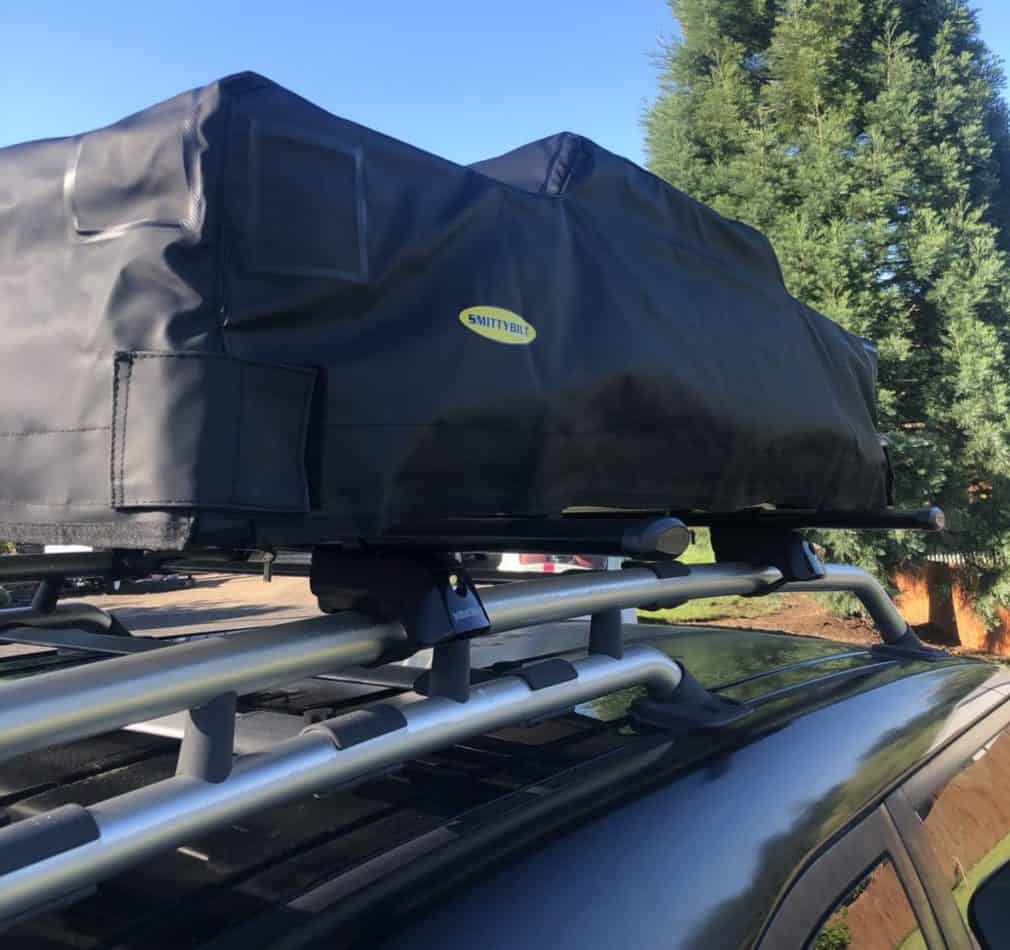
Mounting a roof top tent can be annoying at times and may take you a while to figure out exactly where you want it to sit on your vehicle, trailer, or truck bed.
Rather than spending hours scrolling through endless pages of forums, I wanted to condense that information into one easy to read article.
We will go over some off the different ways to mount your roof top tent (RTT) and the best places to mount them! Depending on where and how you mount your RTT, it can significantly impact the gas mileage and drivability of your vehicle.
Where can you mount your roof top tent?
As no surprise to you, the most common and simple way to mount a RTT is by mounting it to the roof of your vehicle. You can do so by mounting it to an aftermarket crossbar system and a permanent roof rack system.
If you’re looking to buy a roof rack, going with a low profile design will reduce the wind resistance and fuel loss when using a RTT. Not only will the rack sit lower to the vehicle, but also the RTT itself. A good example would be the Front Runner Slimline roof rack. By creating less drag when you drive can improve fuel efficiency and provide a much smoother drive.
Another consideration to make is the amount of weight you need the rack to hold. If you have a 200 pound tent, you will be better of going all in on a permanent roof rack system that can handle that type of weight.
If you’re looking to buy a roof rack or upgrade your current set up, read my article on Choosing a Roof Rack System. It has plenty of examples and my personal recommendations as well!
Trailer
The next option for mounting a RTT is to buy a trailer, preferably an overlanding trailer. Some trailers I would recommend would be CVT’s or FSR’s overlapping trailers, which come with crossbars for the RTT included.
I have listed all of my favorite and must-have roof top tent essentials here if you’re interested in shopping around!
There are many benefits to mounting a RTT to a trailer. First, you can easily mount and unmount it if you need to. You don’t need to lift it nearly as high to put it on top of a vehicle’s roof.
Next, you don’t have to worry about the loss of gas mileage and wear and tear on your vehicle. Many RTT owners leave it on year-round, which adds stress on your drive train over time. Now, you can simply unhitch the trailer and not have to worry about the mounting process ever again!
Truck options

The last option is for trucks in particular. You can mount it on your truck bed, canopy, or even on the cab. Each has their own benefits and reasoning.
I would personally get a truck bed rack because your RTT can sit flush with the cab and not cause any added wind resistance. However, many people need the truck bed space and prefer to get a bed rack that sits really high in order to load plenty of gear into the bed of the truck.
Many truck users have a canopy or camper shell for extra security for their gear. You can mount a RTT onto it with a canopy rack. You simply need to install two tracks where the towers for the roof rack can hold them in place. The installation is straight forward and you can have crossbars or a more robust rack like the Slimline II.
Positioning your roof top tent
Where you position your RTT actually plays a vital role in the wear and tear of your vehicle. When mounting your RTT on the roof of your vehicle, you want to try and center the tent directly in the middle of the vehicle. This helps keep the weight distribution in its natural state.
By no means is this necessary because with trucks or certain racks this isn’t even an option. Plus, some people just prefer to have the tent more towards the front so they can pack gear behind the RTT.
If you want the RTT to open to the back of the vehicle, you would then have to mount it as far back on your rack and vehicle as possible. Many people prefer this set up rather than opening it to the passenger or driver side, and there are many reasons for that.
However, you will have to trim the mounting tracks on your RTT because they are made in the specific length to run perpendicular to crossbars, not parallel.
Mounting Systems for your roof top tent
The mounting process for a RTT can be a total pain. Not only do you need some helping hands, but it is also time-consuming ratcheting down all of the bolts.
You can cut down the set up process to a fraction of the time by buying a quick release mounting system.
A good example of this is the Front Runner Slimline quick release system. By mounting the clamps into place, once installed you will never need tools to mount your RTT again. You simply slide the tent into the brackets and lock it into place. This mechanism works for all RTT types.
If you buy an iKamper RTT, which I highly recommend to anyone considering it, they offer their mounting brackets 2.0 system which comes with their tents. It requires less bolt tightening and locks your tent to your rack for security.
If you find yourself constantly taking your RTT on and off of your vehicle, I would highly suggest springing for a quick release system. Not only will it save you tons of time, but they are also very secure and have locking features.
Best practices for mounting a roof top tent
There are many important measurements to know when mounting your RTT. Things like the dynamic weight limit and width between crossbars are vital measurements to know for a properly secured tent.
That’s why I made a very concise article on exactly how to mount a roof top tent. It’s a very quick and to the point guide that takes you step by step. Things to know before, during, after are all included in this simple mounting guide, with pictures that I took myself included.
Click here to read my article on mounting a RTT the right way!
Wrapping up
Where and how you mount your RTT can vary dramatically. It comes down to how much convenience you want, the amount of weight it can hold, wind resistance, and many more factors.
These are by far the most common ways to mount a RTT and each have their own set of pros and cons. There isn’t a one size fits all answer to which mounting option is the best because it will vary from person to person based on their lifestyle.
I hope this article was able to save you some time scrolling through multiple pages of disjointed information! These are by far the most popular and safe ways to mount a roof top tent.
